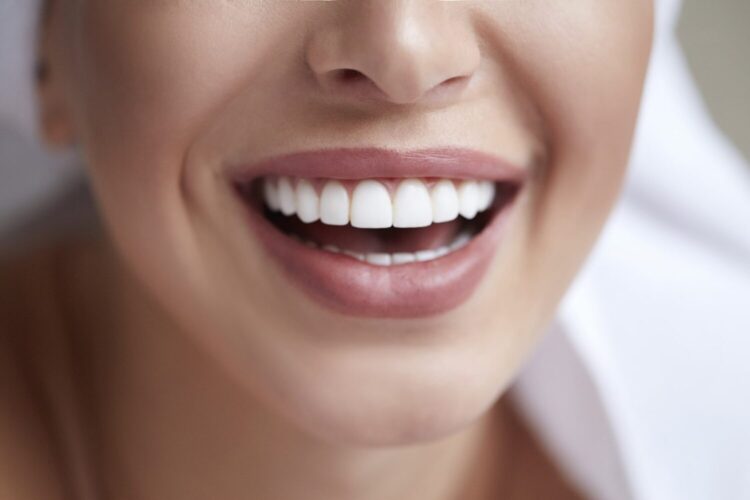A healthy, beautiful smile is the cherished dream of every person. With it, you will not only enjoy the reflection in the mirror but also be able to communicate with others confidently.
What to do to restore damaged, destroyed, or missing teeth? One of the most popular solutions in modern dentistry is installing porcelain crowns.
Porcelain Crowns ─ Main Characteristics
Porcelain dental crowns are a popular restoration method that allows you to restore damaged or decayed tooth shape, size, and function. Why do patients like them so much? There are no secrets — it’s all about their numerous advantages:
- Naturalness ─ The appearance of porcelain crowns is almost identical to natural teeth. Thanks to the ability to choose them according to the color of your enamel, crowns closely imitate healthy teeth and do not attract the attention of others.
- Personalization ─ Each crown is custom-made to match natural teeth size, shape, and color. It guarantees a perfect fit and natural appearance.
- Biocompatibility ─ Porcelain is well tolerated by the body and rarely causes allergic reactions or hypersensitivity. It makes it the optimal material for most patients.
- Durability ─ Porcelain crowns are durable and can withstand daily chewing forces. With proper care and maintenance, they will last for years.
- Resistance to dyes ─ Porcelain is resistant to stains from food and drinks, which helps maintain the aesthetics of the crown throughout its life.
- Conservative preparation ─ Before installing a porcelain crown, the tooth is prepared with the removal of a minimum tissue. In this way, a significant part of the healthy tooth is preserved.
Porcelain crowns are versatile. In addition to restoring decayed teeth, they can be used to strengthen weakened teeth, improve the appearance of misshapen or discolored teeth, and support dental bridges.
While your custom porcelain crown is being made, you can wear a temporary crown to protect the already-prepared tooth. These products are usually acrylic and are not as durable as permanent ones.
The cost of porcelain crowns can vary based on factors such as the type of porcelain used, the tooth location, and the procedure complexity. You can discuss the cost and possible options in consultation with a dentist in NYC.
Indications for the Installation of Porcelain Crowns

- Caries ─ If a tooth has extensive decay that cannot be restored with a filling, a crown can protect the remainder of the tooth.
- Broken or cracked teeth ─ Teeth with severe damage extending below the gum line often require porcelain crowns. Installing them prevents further deterioration and preserves function.
- Weakened teeth ─ When placing large fillings or intensive root canal treatment, crowns provide additional strength and support.
- Deformed or discolored teeth ─ Porcelain crowns can be used to improve the aesthetics of teeth, creating a more natural and attractive appearance.
- Dental bridges ─ Porcelain crowns are anchor points for dental bridges, replacing missing teeth by attaching them to adjacent natural teeth or implants.
- Dental implants ─ Porcelain crowns are often placed over implants to replace missing teeth. These crowns provide the visible and functional part of an artificial tooth.
- Cosmetic improvements ─ Patients seeking cosmetic improvements, such as reshaping teeth or closing gaps between teeth, can choose porcelain crowns as a tool to achieve the smile they desire.
- Worn teeth ─ When teeth are severely worn due to factors such as bruxism or acid erosion, porcelain crowns can restore the original size and shape of the teeth.
- Preventative reasons ─ Dentists may recommend placing a crown on a tooth to prevent future problems. This tactic is worthwhile if doctors expect the tooth to be at risk of developing problems.
How are Porcelain Crowns Made?
Porcelain dental crowns are custom-made for particular patients. The process involves several steps:
- Preparing teeth ─ It involves removing part of the tooth’s outer structure to make room for a crown. The extent of manipulation depends on the crown type and the specific clinical situation.
- Making an impression of the tooth and surrounding area ─ It is to obtain an exact copy of the tooth shape and bite.
- Selection of shades ─ The dentist and dental technician work together to match the color and shade of the porcelain crown to the patient’s natural teeth.
- Installation of a temporary crown ─ It protects the tooth and maintains its proper function and aesthetics.
- Laboratory production ─ The impression and tooth color information is sent to a dental laboratory, where experienced professionals create a porcelain crown. The fabrication process includes creating a stone model, digital design, porcelain build-up, and crown firing, followed by shading and glazing to achieve the desired look and color.
- Crown installation ─ After the porcelain product is made, the patient returns to the dentist, where the temporary crown is removed, and a permanent one is installed, monitoring the fit, correct bite, and aesthetics.
- Cementation ─ The dentist uses dental cement to secure the porcelain crown to the prepared tooth. Excess is removed, and the crown is adjusted to ensure a comfortable bite.
- Final adjustments ─ Once the crown is cemented, your dentist may make additional adjustments to ensure it fits comfortably and functions.
After the crown is placed, the patient receives care instructions and is informed about the need for regular dental check-ups.
How Long Will Crowns Last?

Porcelain crowns can last 10 to 15 years or even longer. However, their longevity depends on several factors, including the quality of the crown, oral hygiene, habits, and care.
Do you want your porcelain crowns to last as long as possible? Please follow these recommendations!
- Maintain oral hygiene ─ Brush your teeth at least twice a day with a soft-bristled toothbrush. Use fluoride toothpaste to prevent tooth decay around the crown and floss daily.
- Avoid overexertion ─ Forget about chewing ice and candy or opening bags with your teeth. If you suffer from bruxism, consider using a night guard to protect your crowns.
- Be attentive to your diet ─ Limit your intake of foods and drinks that can stain your teeth. These include coffee, tea, and red wine in particular. Also, avoid foods and drinks high in acid, as they can destroy the porcelain and cement that holds the crown in place.
- Visit your dentist regularly ─ The doctor will monitor the condition of your crown and promptly take the necessary measures if discomfort, loosening, damage, or other problems occur.
- Protect your teeth from injury ─ If you participate in contact sports or activities that put you at risk of oral injury, consider wearing a mouthguard to protect your crowns and natural teeth.
Conclusions
Porcelain crowns are an effective dental tool that restores a beautiful smile and improves quality of life. If you have any questions about crowns, don’t hesitate to ask your dentist for recommendations for installation and care instructions tailored to your situation.
 Hi Boox Popular Magazine 2024
Hi Boox Popular Magazine 2024



